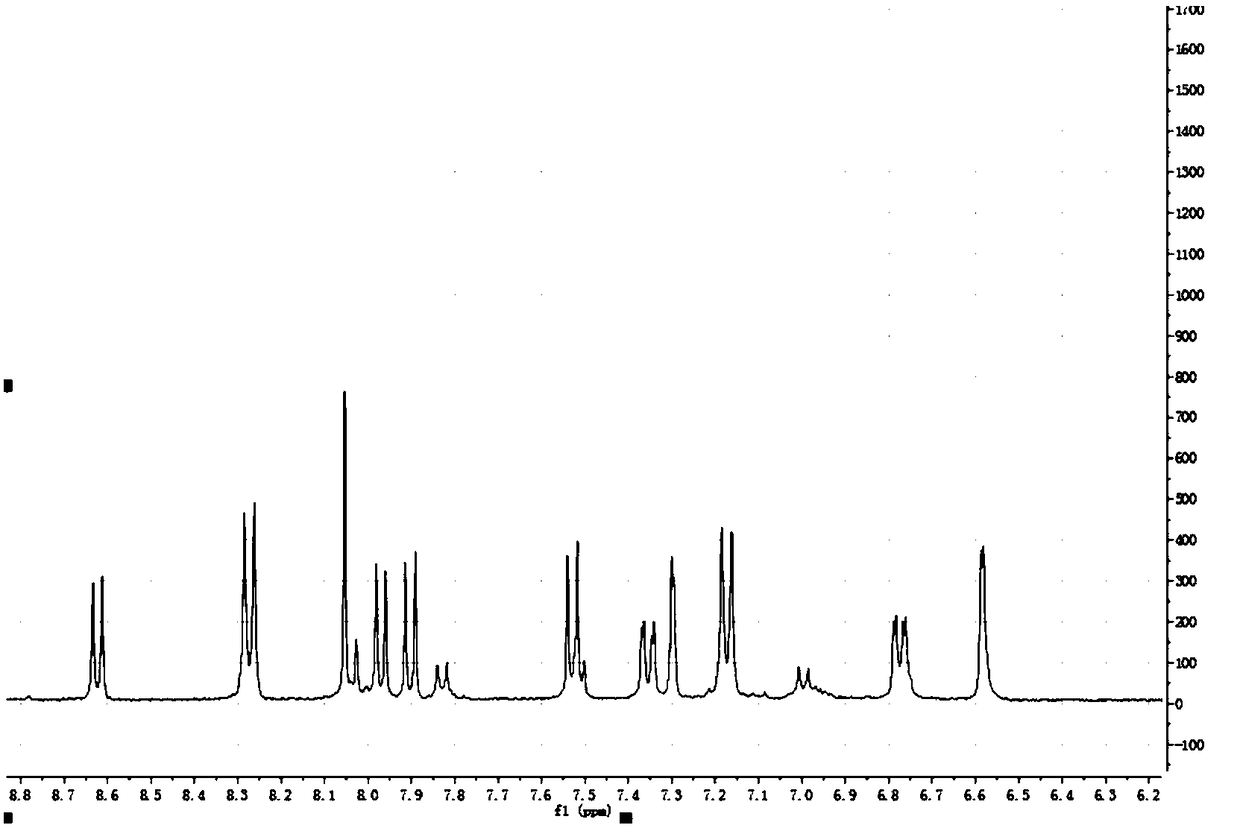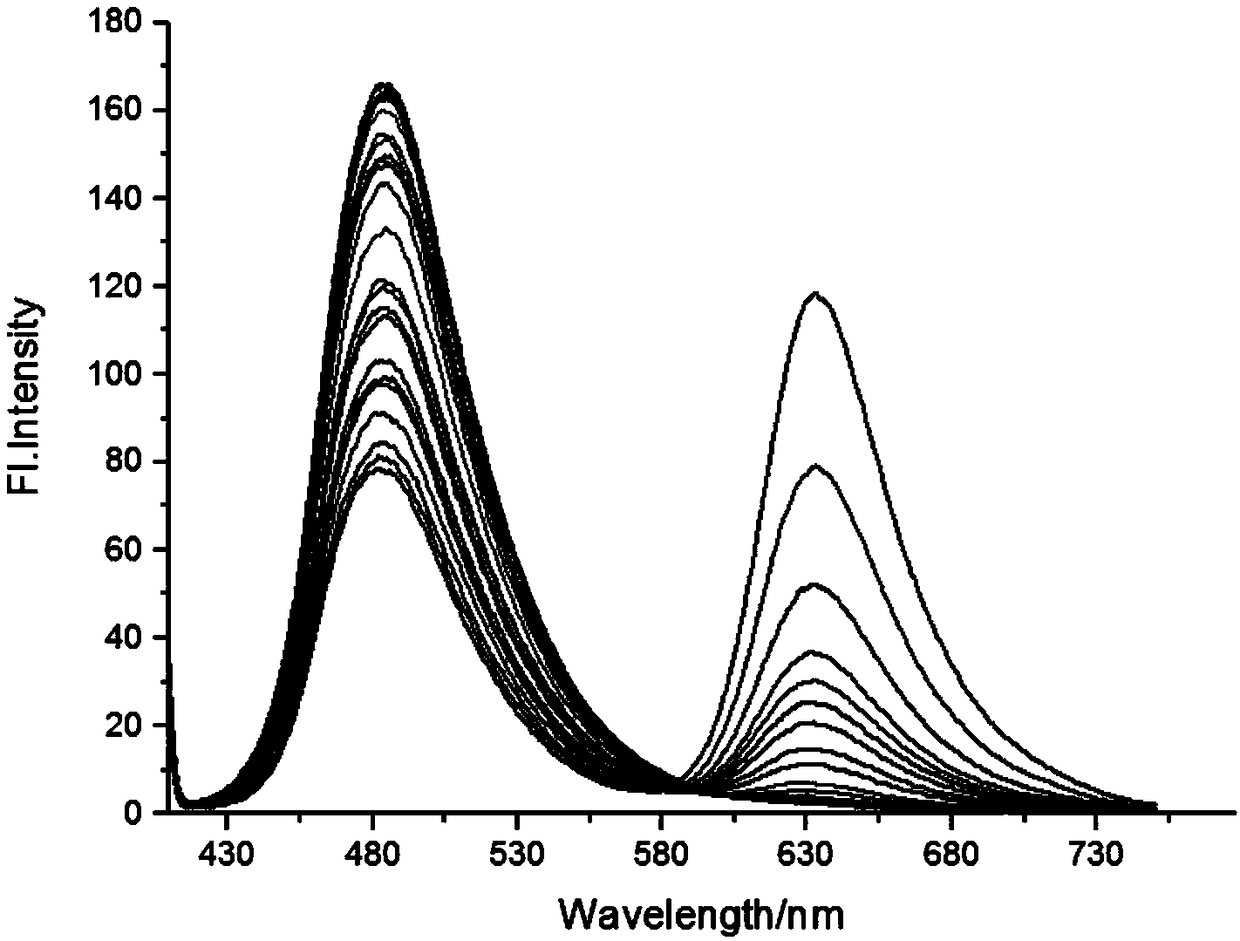Ratiometric fluorescent probe of targeting mitochondria for sulfur dioxide
A sulfur dioxide, fluorescent probe technology, applied in fluorescence/phosphorescence, luminescent materials, organic chemistry, etc., can solve problems such as lack, and achieve the effects of low preparation cost, readily available raw materials, and simple and easy synthesis process
- Summary
- Abstract
- Description
- Claims
- Application Information
AI Technical Summary
Problems solved by technology
Method used
Image
Examples
Embodiment 1
[0034] Example 1 Synthesis of Fluorescent Probes
[0035] (1) 7-diethylaminocoumarin (1 mmol) and p-piperazine acetophenone (1 mmol) in 1-hydroxybenzotriazole (0.5 mmol), 1-(3-dimethylaminopropyl) In the presence of -3-ethylcarbodiimide (3 mmol), N,N-diisopropylethylamine (0.1mL) and N,N-dimethylformamide (5mL), add to a 25 mL one-necked flask , stirred at room temperature for 5 hours. Use water-dichloromethane to extract, and obtain compound 4 after spin-drying the solvent:
[0036] ;
[0037] (2) 4-Diethylaminosalicylaldehyde (0.6mmol) and 3-(4-(4-acetylphenyl)piperazine-1-carbonyl)-7-diethylaminobenzene obtained in step (1) Pyrone was heated and reacted in the presence of concentrated sulfuric acid (5mL), stirred at 90°C for 2.5h, poured the resulting solution into ice water, added 4mL of perchloric acid, precipitated a solid, suction filtered, dried to obtain a solid, and then dichloro Methane:methanol=28.5:1 (v:v) was purified by column chromatography, and the purpl...
Embodiment 2
[0039] Example 2 Fluorescent Spectrum Test of Fluorescent Probes to Detect Different Concentrations of Sulfur Dioxide
[0040] Prepare different concentrations of sodium bisulfite buffer solutions (concentrations are 0, 1, 2, 5, 5.0, 10, 15, 20, 25, 30, 35, 40, 45, 50 μM), which contain the fluorescent Probe 10 μM, ethanol 5%wt, pH 7.4; fluorescence detection (λ ex =400 nm), record the fluorescence intensity at 483nm and 635nm, such as image 3 shown. Detect the fluorescence intensity of different concentrations of sodium bisulfite buffer solution (concentrations are 0-200μM) in the same way, and analyze I 483nm / I 635nm The linear relationship between the fluorescence intensity at and the concentration of sulfur dioxide, such as Figure 4 Shown: As the concentration of sodium bisulfite increases, the absorption peak at 483 nm gradually increases, and the absorption peak at 635 nm gradually decreases. When the concentration of sodium bisulfite reaches 100 μM, the absorptio...
Embodiment 3
[0041] Example 3 Selectivity of Fluorescent Probes
[0042] Various ions, amino acids and reactive oxygen species / reactive nitrogen solutions with a concentration of 100 mM were prepared as backup.
[0043] The solution of sodium sulfite and different interfering substances and the probe was prepared into a buffer solution (ethanol 5%wt, pH 7.4), the final concentration of interfering substances was 20 μM, the final concentration of probe was 10 μM, and the fluorescence detection was performed after shaking well (λ ex = 400 nm), to establish the fluorescence intensity ratio I 483nm / I635nm Histogram with each interfering substance, such as Figure 5 Shown: The interfering substances added in No. 1-10 are: blank, KI, CaCl 2 , FeSO 4 , Cys, NaClO, MgCl 2 , NaBr, ZnCl 2 、CuSO 4 、NiSO 4 , GSH, H 2 o 2 , SnCl 2 , TBHP, DBTP, NaCl, NaF, CoCl 2 , Fe 2 (SO 4 ) 3 、Na 2 S, probe. Depend on Figure 5 It can be seen that the fluorescent probe has a low fluorescence respon...
PUM
 Login to View More
Login to View More Abstract
Description
Claims
Application Information
 Login to View More
Login to View More - R&D
- Intellectual Property
- Life Sciences
- Materials
- Tech Scout
- Unparalleled Data Quality
- Higher Quality Content
- 60% Fewer Hallucinations
Browse by: Latest US Patents, China's latest patents, Technical Efficacy Thesaurus, Application Domain, Technology Topic, Popular Technical Reports.
© 2025 PatSnap. All rights reserved.Legal|Privacy policy|Modern Slavery Act Transparency Statement|Sitemap|About US| Contact US: help@patsnap.com



